Research on the Application of BRBs in Seismic Resistance of Bridge
Abstract
:1. Introduction
2. New Types and Materials of Buckling-Restrained Braces (BRBs)
2.1. Basic Composition and Principle
2.2. Research Status of BRBs
2.3. Study on Self-Centering Buckling-Restrained Brace (SC-BRB)
2.4. Study on New Materials of BRBs
3. Study on Seismic Performances of BRBs
3.1. Seismic Performances of BRBs on Piers and Columns
3.2. Seismic Performances of BRBs on Girder Bridges
3.3. Seismic Performances of BRBs on Cable-Stayed Bridges
3.4. Seismic Performance of BRB on Arch Bridges
3.5. Study of BRBs on Actual Bridges
3.6. Research on BRBs at the Nodes
4. Damping Effect of BRB
4.1. Comparison of BRB with Other Seismic Isolation Components
4.2. Combining BRBs with Other Seismic Isolation Components
5. Conclusions and Expectations
- (1)
- The damping effect of the BRB is closely related to its yield strength, layout form, structure styles, and other parameters. Using new materials and new structures, the BRB form is simplified and easy to install and disassemble so as to meet the economic applicability of the bridge structure with replaceable components. Different parameters and arrangements of the BRB have been tested and simulated to improve the hysteresis performances of BRBs and to mitigate the responses of bridges at critical locations to select a reasonable damping solution.
- (2)
- Most of the BRB placement positions have been on pier columns, and there has been little study on whether the placement in other positions has a good damping effect on bridges. This paper proposes the idea of using BRBs in the superstructures of arch bridges and cable-stayed bridges and proves its feasibility in theory.
- (3)
- The connection nodes between BRBs and structures have an impact on structural deformation. Ensuring the stability and reliability of the nodes can fully exploit and enhance the energy dissipation of the BRB. The nodes connecting BRBs and bridges are not well studied and need to be studied independently. The node parameters need to be further determined according to the structure and BRB.
- (4)
- Compared with other damping and isolation devices, BRBs show better performances, and when used with other components simultaneously, the whole bridge will achieve a better damping effect. The location of the seismic isolation components should be arranged according to the damage control parts of the bridge, and the type should be selected according to the structure of the bridge. There are many kinds of energy dissipation devices with strong nonlinearity and different damping mechanisms, so there is a large research space for the determination of their seismic capacity.
6. Patents
Author Contributions
Funding
Institutional Review Board Statement
Informed Consent Statement
Data Availability Statement
Conflicts of Interest
References
- Yoshino, T.; Karino, Y. Experimental study on shear wall with braces: Part 2. Summaries of technical papers of annual meeting. Archit. Inst. Jpn. Struct. Eng. Sect. 1971, 11, 403–404. [Google Scholar]
- Wakabayashi, M.; Nakamura, T.; Katagihara, A.; Yogoyama, H.; Morisono, T. Experimental study on the elastoplastic behavior of braces enclosed by precast concrete panels under horizontal cyclic loading: Parts1&2. Summ. Tech. Pap. Annu. Meet. 1973, 6, 1041–1044. [Google Scholar]
- Aiken, I.D.; Mahin, S.A.; Uriz, P. Large-scale testing of buckling restrained braced frames. In Proceedings, Japan Passive Control Symposium; Tokyo Institute of Technology Yokohama: Tokyo, Japan, 2002. [Google Scholar]
- Hao, C.; Guo, S.; Wei, Y. Hysteretic behavior of new type ductile assembled buckling-resistant braces. J. Suzhou Univ. Sci. Technol. (Eng. Technol.) 2021, 34, 29–36. [Google Scholar]
- Ying, Z.; Qiang, Z.; Wei, Q.; Si, W. Study on the new type of double square steel tube buckling restrained braces with restraint built-in. Earthq. Resist. Eng. Retrofit. 2020, 42, 41–46. [Google Scholar]
- Tsai, K.C.; Hwang, Y.C.; Weng, C.S. Seismic Performance and Applications of Double-Tube Buckling-Restrained Brace. Prog. Steel Build. Struct. 2005, 7, 1–8. [Google Scholar]
- Yan, G.; Bo, Z.; Zi, J.; Hang, C. Critical load and application of core-separated buckling-restrained braces. J. Constr. Steel Res. 2015, 106, 1–10. [Google Scholar]
- Yan, G.; Jing, T.; Bo, Z.; Bo, Z.; Yong, P. Theoretical and experimental investigation of core-separated buckling-restrained braces. J. Constr. Steel Res. 2017, 135, 137–149. [Google Scholar]
- Cong, Z.; Yi, Z.; Guo, S.; Tao, W.; Tian, P.; De, W. Quasi-Static Cyclic Tests on The Hysteretic Behavior of Buckling-Restrained Braces with A T-section Core. Eng. Mech. 2021, 38, 124–132, 181. [Google Scholar]
- Cahís, X.; Simon, E.; Piedrafita, D.; Catalan, A. Core behavior and low-cycle fatigue estimation of the Perforated Core Buckling-Restrained Brace. Eng. Struct. 2018, 174, 126–138. [Google Scholar] [CrossRef]
- Yun, Z.; Chen, G.; Gen, Z.; Shi, T. Study on design method of perforated steel-plate assembled buckling-restrained brace. China Civ. Eng. J. 2019, 52, 57–65. [Google Scholar]
- Yan, S.; Zheng, Z.; Hong, Q.; Jian, H.; Zhi, S. Toggle buckling-restrained brace systems and a corresponding design method for the seismic retrofit of bridge bents. Eng. Struct. 2020, 221, 110996. [Google Scholar]
- Bao, H.; Qing, X. Theoretical Study and Numerical Analysis of “Cross-Like” Double Yield Buckling Restrained Brace. Prog. Steel Build. Struct. 2022, 24, 98–107. [Google Scholar]
- Guo, W.; Li, J.; Xiang, N. Seismic Performance of the Buckling-Restrained Brace Central Buckle for Long-Span Suspension Bridges. J. Earthq. Tsunami 2018, 12, 1850015. [Google Scholar] [CrossRef]
- Wei, L.; Song, S.; Xin, Q.; You, P.; Qi, Q. Study of Seismic Mitigation Performance of BRB Central Buckle of Suspension Bridge. Bridge Constr. 2022, 52, 61–68. [Google Scholar]
- Yan, G.; Peng, Z.; Meng, W.; Yong, P.; Mark, B.; Jing, T. Experimental and numerical studies of hysteretic response of triple truss-confined buckling-restrained braces. Eng. Struct. 2017, 148, 157–174. [Google Scholar]
- Chun, W.; Ye, L.; Li, Z. Experimental and numerical studies on hysteretic behavior of all-steel bamboo-shaped energy dissipaters. Eng. Struct. 2018, 165, 38–49. [Google Scholar]
- Arash, A.H.; Hashemi, S.S. Parametric study on the structural performance of ordinary, bamboo-shaped and triple-truss confined all-steel BRBs with a circular core cross-section. Asian J. Civ. Eng. 2023, 1, 17. [Google Scholar]
- Xi, L.; Yun, C.; Yuan, M. A new concept of structural aseismic design—Recoverable functional structure. J. Tongji Univ. (Nat. Sci.) 2011, 39, 941–948. [Google Scholar]
- Xi, L.; Ying, Z.; Cong, C. Research progress on innovative earthquake-resilient structural systems. Harbin 2014, 34, 130–139. [Google Scholar]
- Christopoulos, C.; Tremblay, R.; Kim, H.; Lacerte, M. Self-Centering Energy Dissipative Bracing System for the Seismic Resistance of Structures: Development and Validation. J. Struct. Eng. 2008, 134, 96–107. [Google Scholar] [CrossRef]
- Tremblay, R.; Lacerte, M.; Christopoulos, C. Seismic Response of Multistory Buildings with Self-Centering Energy Dissipative Steel Braces. J. Struct. Eng. 2008, 134, 108–120. [Google Scholar] [CrossRef]
- Yun, C.; Yi, C.; Huan, J.; Dong, Y.; Bao, C. Research progress in self-centering energy dissipating braces. Earthq. Eng. Eng. Vib. 2014, 34, 239–246. [Google Scholar]
- Ying, Z.; Yi, X.; An, G. Self-centering braced rocking frame systems and displacement-based seismic design method. J. Build. Struct. 2019, 40, 17–26. [Google Scholar]
- Qiang, H.; Zhen, J.; Yu, Z. Review of Seismic Resilient Bridges Structures: Rocking Bridges. China J. Highw. Transp. 2021, 34, 118–133. [Google Scholar]
- Han, Q.; Jia, Z.; Xu, K.; Yu, Z.; Xiu, D. Hysteretic Behavior Investigation of Self-centering Double-column Rocking Piers for Seismic Resilience. Eng. Struct. 2019, 188, 218–232. [Google Scholar] [CrossRef]
- White, S.; Palermo, A. Quasi-static Testing of Posttensioned Nonemulative Column-footing Connections for Bridge Piers. J. Bridge Eng. 2016, 21, 04016025. [Google Scholar] [CrossRef]
- Long, X.; Peng, C. The Hysteretic Behavior and Working Mechanism of Self-Centering Steel Buckling-Restrained Braces. Eng. Mech. 2020, 37, 147–156. [Google Scholar]
- Qiang, H.; Zhen, J.; Xiao, W.; Chao, W. Behavior Test and Restoring Force Model of Disc-Spring Self-Centering Buckling-Restrained Braces. Eng. Mech. 2018, 35, 144–150, 190. [Google Scholar]
- Hui, D.; Xiu, L.; Qiang, H.; Hong, B.; Kai, B.; Xiao, W. Performance of an innovative self-centering buckling restrained brace for mitigating seismic responses of bridge structures with double-column piers. Eng. Struct. 2017, 148, 47–62. [Google Scholar]
- Chou, C.; Tsai, W.; Chung, P. Development and validation tests of a dual-core self-centering sandwiched buckling-restrained brace (SC-SBRB) for seismic resistance. Eng. Struct. 2016, 121, 30–41. [Google Scholar] [CrossRef]
- Alireza, T.; Mieczysław, K.; Magdalena, Ł.; Ehsan, F.; Mohamamd, N.; Paolo, G.; Shao, L. Application and modelling of Shape-Memory Alloys for structural vibration control: State-of-the-art review. Constr. Build. Mater. Part B 2022, 342, 127975. [Google Scholar]
- Seyede, H.; Pouraminian, M.; Abbas, S.; Somayyeh, P. Probabilistic Assessment the Seismic Collapse Capacity of Buckling-Restrained Braced Frames Equipped with Shape Memory Alloys. J. Struct. Constr. Eng. 2021, 8, 129–149. [Google Scholar]
- Can, Q.; Ai, Z.; Tian, J.; Xiu, D. Seismic performance analysis of multi-story steel frames equipped with FeSMA BRBs. Soil Dyn. Earthq. Eng. 2022, 161, 107392. [Google Scholar]
- Yin, S. Bridge Structure Based on New SMA-Buckling Constrained Support Shock Absorption Analysis; Yanshan University: Qinhuangdao, China, 2020. [Google Scholar]
- Jun, Z.; Hui, W.; Jun, D.; Li, Z. Experimental Study of Maintenance-Free Steel-Composite Buckling Restrained Braces. Materials 2022, 15, 5538. [Google Scholar]
- Guo, L.; He, Y.; Zeng, Q. Hysteresis performance test of double aluminum alloy plate assembled buckling restrained braces. J. Build. Struct. 2022, 6, 13. [Google Scholar]
- Yan, Y.; Ting, H.; Bo, W.; Yu, C. Experimental study and finite element analysis for improved BRB of combined angle steel. Build. Struct. 2021, 51, 3. [Google Scholar]
- Ai, Y.; Zhong, G.; Li, F. Seismic Design of Bridge; China Communications Press: Beijing, China, 2017. [Google Scholar]
- Xiao, L.; Zhi, S.; Xin, L.; Dong, W. Seismic responses of double column bridge bents with buckling-restrained braces in mountain areas. J. Vib. Shock. 2018, 37, 173–180. [Google Scholar]
- Wen, X.; Li, S. Research on seismic damage control of double-column high piers based on the concept of structural “fuse”. J. Vib. Eng. 2016, 3, 420–428. [Google Scholar]
- Yang, D.; Yong, Z.; Lei, Z. Analysis on transverse damping performance of double column pier with BRB. Earthq. Eng. Eng. Vib. 2018, 38, 117–123. [Google Scholar]
- Wei, L.; Xiu, X.; Yao, H. Influence of BRB Layout Principle on Seismic Response of High-Rise Pier with Replaceable Components. World Bridges 2022, 50, 81–87. [Google Scholar]
- Wan, Z.; Yong, Z.; Huai, L.; Wen, G.; Hao, X. Study on the Seismic Mitigation Effect of Continuous Rigid Frame Bridge with Buckling Restrained Brace. Technol. Highw. Transp. 2020, 6, 54–59. [Google Scholar]
- Yan, S.; Jun, L.; Hong, Q.; Dong, W.; Jun, W.; Zhi, S. Review on Seismic Performance of Bridge Double-column Bents. China J. Highw. Transp. 2021, 34, 134–154. [Google Scholar]
- Yan, S.; Zhan, Z.; Jian, H.; Ji, X. Parametric Analysis of Seismic Performance for Bridge Bents with Buckling-restrained Braces (BRBs). J. Sichuan Univ. (Eng. Sci. Ed.) 2018, 50, 71–76, 90. [Google Scholar]
- Yan, S.; Dong, W.; Jian, H. Displacement-based design method for bridge bents with buckling-restrained braces (BRBs). China Civ. Eng. J. 2017, 50, 62–68, 128. [Google Scholar]
- Zhi, S.; Cheng, H.; Yan, S.; Dong, W. Seismic design of bridge bents with BRB as a structural fuse. J. Vib. Shock. 2015, 34, 199–205. [Google Scholar]
- El-Bahey, S.; Bruneau, M. Buckling restrained braces as structural fuses for the seismic retrofit of reinforced concrete bridge bents. Eng. Struct. 2011, 33, 1052–1061. [Google Scholar] [CrossRef]
- Yong, Z.; Yang, D.; Lei, Z. Seismic System of Double-column Bridge Piers. China Earthq. Eng. J. 2018, 40, 957–962. [Google Scholar]
- Lyle, P.; Ahmad, M.; Ian, G. Seismic Performance of Steel Girder Bridges with Ductile Cross Frames Using Buckling-Restrained Braces. J. Struct. Eng. 2006, 132, 338–345. [Google Scholar]
- Lyle, P.; Ahmad, M.; Ian, G. Seismic Performance of Steel Girder Bridges with Ductile Cross Frames Using Single Angle X Braces. J. Struct. Eng. 2006, 132, 329–337. [Google Scholar]
- Upadhyay, A.; Pantelides, C.; Ibarra, L. Residual drift mitigation for bridges retrofitted with buckling restrained braces or self-centering energy dissipation devices. Eng. Struct. 2019, 199, 109663. [Google Scholar] [CrossRef]
- Upadhyay, A.; Pantelides, C.; Ibarra, L. Seismic Performance of Curved Bridges on Soft Soils Retrofitted with Buckling Restrained Braces. In ASCE Specialty Conference, Proceedings; ASCE: Reston, VA, USA, 2015. [Google Scholar]
- Bazaez, R.; Dusicka, P. Cyclic behavior of reinforced concrete bridge bent retrofitted with buckling restrained braces. Eng. Struct. 2016, 119, 34–48. [Google Scholar] [CrossRef]
- Bazaez, R.; Dusicka, P. Performance assessment of multi-column RC bridge bents seismically retrofitted with buckling-restrained braces. Bull. Earthq. Eng. 2018, 16, 2135–2160. [Google Scholar] [CrossRef]
- Chen, X.; Li, C. Seismic assessment of tall pier bridges with double-column bents retrofitted with buckling restrained braces subjected to near-fault motions. Eng. Struct. 2021, 226, 111390. [Google Scholar] [CrossRef]
- Yuan, W.; Luis, I.; Pantelides, C. Seismic Retrofit of a Three-Span RC Bridge with Buckling-Restrained Braces. Bridge Eng. 2016, 21, 4016073. [Google Scholar]
- Ijan, D.; Chris, P. Resilient Posttensioned Bridge Bent with Buckling Restrained Brace. Bridge Eng. 2022, 27, 04021107. [Google Scholar]
- Ijan, D.; Chris, P. Seismic Analysis of Posttensioned and Hybrid Bridge Bents with Buckling Restrained Braces. Bridge Eng. 2023, 28, 04022146. [Google Scholar]
- Hui, D.; Yu, B.; Qiang, H.; Xiu, D. Mechanical Performance of New Type of Self-centering Energy Dissipation Brace and Its Application in Double-column Bridge Structures. China J. High W. Transp. 2017, 30, 196–204. [Google Scholar]
- Oguz, C.; Michel, B. Seismic behavior of bidirectional-resistant ductile end diaphragms with buckling restrained braces in straight steel bridges. Eng. Struct. 2009, 31, 380–393. [Google Scholar]
- Xiao, W.; Michel, B. Experimental Investigation of Buckling Restrained Braces for Bridge Bidirectional Ductile End Diaphragms. J. Struct. Eng. 2018, 144, 04018048. [Google Scholar]
- Xiao, W.; Luna, N.; Michel, B. Low-Cycle Fatigue of Buckling Restrained Braces in Bidirectional Ductile End Diaphragms Due to Temperature-Change Effect on Bridge Superstructure. J. Bridge Eng. 2019, 24, 04019014. [Google Scholar]
- Li, S.; Jun, W.; Jian, L.; Hong, W. Numerical Investigation of Seismic Performance of Energy Dissipation Subsidiary Piers. Eng. Mech. 2014, 31, 57–67. [Google Scholar]
- Chao, Z.; Lue, Q.; Xia, X.; Jun, S. Study of Transverse Seismic Protection Measures for Pier Columns in Side Spans of Cable-Stayed Bridge with Low Gravity Center. World Bridges 2020, 48, 65–70. [Google Scholar]
- Xiao, L.; Dong, W.; Zhi, S. Seismic Structure of Long Span Cable-Stayed Bridge with Buckling Restrained Brace. U.S. Patent CN201620827938.5, 4 January 2017. [Google Scholar]
- Bao, C.; Dong, W.; Hong, L.; Shao, C.; Chao, L. Shock-absorbing restraint system and its seismic response of sea-crossing cable-stayed bridge installing BRB between towers and girders. J. Vib. Eng. 2021, 34, 452–461. [Google Scholar]
- Chen, B.; He, S.; Du, Y.; Chen, S.; Gao, J. Considering the interaction of seawater, seabed and cable-stayed bridge, the damping effect and optimal design of longitudinal BRBS. J. Vib. Eng. 2023, 1–13. Available online: http://zdxb.nuaa.edu.cn/zdgcxb/article/abstract/202208040 (accessed on 29 June 2021).
- Usami, T.; Lu, Z.; Ge, H. A seismic upgrading method for steel arch bridges using buckling-restrained braces. Earthq. Eng. Struct. Dyn. 2005, 34, 471–496. [Google Scholar] [CrossRef]
- Chen, X.; Ge, H.; Usami, T. Seismic Demand of Buckling-Restrained Braces Installed in Steel Arch Bridges Under Repeated Earthquakes. J. Earthq. Tsunami 2011, 5, 119–150. [Google Scholar] [CrossRef]
- Yong, Z.; Yang, D.; Shang, Q.; Xing, C.; Ming, D. Research on the Damping Performance of the Long-span Deck Type Steel Truss Railway Arch Bridge. J. Railw. Eng. Soc. 2016, 33, 75–79. [Google Scholar]
- Xiao, L.; Yu, Z.; Wang, D. Earthquake damage characteristics and research of arch bridges under strong earthquake. World Earthq. Eng. 2018, 34, 33–43. [Google Scholar]
- Xiao, L.; Wang, D.; Zhi, S.; Yan, S. A new transverse seismic structure system of ribbed arch bridge with buckling restrained brace. U.S. Patent CN201320427345.6, 18 December 2013. [Google Scholar]
- Hao, G.; Kun, Z.; Xin, W.; Hong, L.; Lian, Z. Application of BRB to Seismic Mitigation of Steel Truss Arch Bridge Subjected to Near-Fault Ground Motions. Buildings 2022, 12, 2147. [Google Scholar]
- Chang, S.; Hao, C.; Qi, Q.; Chun, W.; Wei, Z. Transverse seismic mitigation of long-span RC light flexible arch bridge with BRBs under long-period ground motions. J. Railw. Sci. Eng. 2022. Available online: https://wap.cnki.net/touch/web/Journal/Article/CSTD20221120003.html (accessed on 1 February 2023).
- Dominik, S.; Andelko, V.; Marija, K.; Mladen, S.; Ana Mandi, I. Seismic Assessment and Retrofitting of Existing Road Bridges: State of the Art Review. Materials 2022, 15, 2523. [Google Scholar]
- He, G.; Sheng, H.; Zhong, G. Damping and isolation system design of cable-stayed concrete girder bridge in strong earthquake area. Highway 2015, 60, 130–135. [Google Scholar]
- Available online: https://www.nxnews.net/cj/xydt/202108/t20210824_7246412.html (accessed on 12 April 2022).
- Kanaji, H.; Hamada, N.; Ishibashi, T.; Amako, M.; Oryu, T. Design and Performance Tests of Buckling Restrained Braces for Seismic Retrofit of a Long-Span Bridge. In 21th US–Japan Bridge Engineering Workshop. Panel on Wind and Seismic Effects. 2005. Available online: https://www.pwri.go.jp/eng/ujnr/tc/g/pdf/21/21-4-3kanaji.pdf (accessed on 18 September 2021).
- Hidesada, K.; Masahiko, K.; Naoto, S. Seismic Retrofit Strategy Using Damage Control Design Concept and the Response Reduction Effect for a Long-Span Truss Bridge. In 19th US–Japan Bridge Engineering Workshop. Panel on Wind and Seismic Effects. 2003. Available online: https://www.pwri.go.jp/eng/ujnr/tc/g/pdf/19/6-1kanaji.pdf (accessed on 18 September 2021).
- Usami, T. JI Bohai Translation. In Guidelines for Seismic and Damage Control Design of Steel Bridge; Hohai University Press: Nanjing, China, 2008. (In Chinese) [Google Scholar]
- Li, J.Z. Recent Advances in Seismic Design for Long Span Bridges in China. In Proceedings of the 16th World Conference on Earthquake, 16WCEE 2017, Santiago, Chile, 9–13 January 2017. [Google Scholar]
- Guo, Z.; Zuo, S.; Meng, D.; Zi, Z. Research on seismic performance of buckling-restrained braced-rocking steel frame. J. Build. Struct. 2021, 4, 50–60. [Google Scholar]
- Jun, Z.; Jia, S.; Jia, Z.; Hai, Y.; Yuan, Z.; Bai, W. Subassemblage tests of buckling-restrained braced RC frame with sliding gusset connection. J. Build. Struct. 2021, 43, 207. [Google Scholar]
- Jiu, B.; Ming, F.; Wen, L.; Hui, C.; Ming, L.; Shuang, J. The Seismic Performance of a New PBL-Type Connection in Buckling-Restrained Braced Reinforced Concrete Frames. Eng. Mech. 2022, 39, 110–121. [Google Scholar]
- Zhuang, L.; Xue, S.; Yong, C.; Yun, Z. Analysis study on the performance of end directly connected triple steel tube buckling-restrained brace. China Civ. Eng. J. 2022, 55, 25–31. [Google Scholar]
- Wang, F.; Ji, R.; Xia, X. Research on Influence of Pier Height of Low-Tower Cable-stayed Bridge on Seismic Isolation Performance of Friction Pendulum Bearing. Highw. Eng. 2022, 6, 1–9. [Google Scholar]
- Hai, C. Study on Performance of Seismic Isolation Bearing of Seismic Excitation Bridge Foundation. Highw. Eng. 2018, 43, 108–112. [Google Scholar]
- Li, J.; Chen, G. Method to compute live-load distribution in bridge girders. Pract. Period. Struct. Des. Constr. 2011, 16, 191–198. [Google Scholar] [CrossRef]
- Yan, S.; Dong, W.; Jan, H.; Zhi, S.; Zhan, Z. Application status of seismic isolation for bridges and its development tendency. Earthq. Eng. Eng. Vib. 2017, 37, 118–128. [Google Scholar]
- Marco, F. Definition and Validation of Fast Design Procedures for Seismic Isolation Systems. Vibration 2022, 5, 290–305. [Google Scholar]
- Alper, K.; Carlo, C. Reducing the seismic vulnerability of existing elevated silos by means of base isolation devices. Eng. Struct. 2017, 143, 477–497. [Google Scholar]
- Young, K.; Hasan, S.; Jong, H. Seismic Performance Evaluation According to HSS and CFST Columns of 3D Frame Buildings with Rubber Friction Bearing (RFB). Materials 2022, 15, 1281. [Google Scholar]
- Afshin, M.; Dario, D.; Hamid, D. Seismic Rehabilitation of Steel Arch Bridges Using Nonlinear Viscous Dampers: Application to a Case Study. Pract. Period. Struct. Des. Constr. 2021, 26, 04021012. [Google Scholar]
- Li, C.; Liu, Y.; Li, H.N. Fragility assessment and optimum design of a steel–concrete frame structure with hybrid energy-dissipated devices under multi-hazards of earthquake and wind. Eng. Struct. 2021, 245, 112878. [Google Scholar] [CrossRef]
- Qun, L.; Zhao, G.; Shi, Z.; Chang, W.; Xiang, R.; Xing, W. Performance-Based Seismic Design of Hybrid Isolation Systems with Gap-T unable BRBs for Bearing-Supported Bridges. Symmetry 2022, 14, 1373. [Google Scholar]
- Zhong, G.; Han, Y.; Jian, L. Lateral Isolation System of a Long-Span Cable-Stayed Bridge with Heavyweight Concrete Girder in a High Seismic Region. Bridge Eng. 2017, 22, 04016104. [Google Scholar]
- Zi, L.; Li, L.; Yang, Z.; Yu, L. Research on the influence law of Lock-Up Self-Centering Buckling-Restrained Braces on bridge performance. World Earthq. Eng. 2020, 36, 146–154. [Google Scholar]
- Lanning, J.; Benzoni, G.; Uang, C.M. Using Buckling-Restrained Braces on Long-Span Bridges I: Full-Scale Testing and Design Implications. Bridge Eng. 2016, 21, 4016001. [Google Scholar] [CrossRef]
- Lanning, J.; Benzoni, G.; Uang, C.M. Using Buckling-Restrained Braces on Long-Span Bridges. II: Feasibility and Development of a Near-Fault Loading Protocol. J. Bridge Eng. 2016, 21, 04016002. [Google Scholar] [CrossRef]
- Upadhyay, A.; Pantelides, C.P. Comparison of the Seismic Retrofit of a Three-Column Bridge Bent with Buckling Restrained Braces and Self Centering Braces. Struct. Congr. 2000: Adv. Technol. Struct. Eng. 2017, 2017, 414–423. [Google Scholar]
- Montazeri, M.; Ghodrati, G.; Namiranian, P. Seismic fragility and cost-benefit analysis of a conventional bridge with retrofit implements. Soil Dyn. Earthq. Eng. 2021, 141, 106456. [Google Scholar] [CrossRef]
- Hui, D.; Xiu, D.; Qiang, H.; Kai, B.; Hong, H. Hysteretic performance of RC double-column bridge piers with self-centering buckling-restrained braces. Bull. Earthq. Eng. 2019, 17, 3255–3281. [Google Scholar]
- Zi, L.; Dong, W.; Lei, C.; Lei, T. Seismic response of bidirectional isolation bridges using BRBs under near-fault ground motions. World Earthq. Eng. 2020, 36, 155–162. [Google Scholar]
- Wei, L.; Zhao, H.; Yu, L. Application of BRB in seismic isolation of curved bridges under near—Fault earthquakes. Earthq. Resist. Eng. Retrofit. 2020, 42, 130–136. [Google Scholar]
- Yan, S.; Zhang, Z.; Hong, Q.; Xiang, Z.; Xiong, Y. Lateral Seismic Response and Self-Centering Performance of a Long-Span Railway Continuous Beam-Arch Bridge. Shock. Vib. 2020, 2020, 4547532. [Google Scholar]
- Yan, S.; Zhan, Z.; Jian, H.; Bao, C. Self-centering performance of long-span railway continuous beam-arch bridge subjected to near-fault ground motions. J. Harbin Eng. Univ. 2020, 41, 390–396. [Google Scholar]
- Wei, B.; Jun, W.; Chen, X.; Tao, P.; Jin, G. Damping mechanism and influential parameters of a hybrid shock absorption system for railway simply-supported girder bridges with unequal spans. J. Vib. Shock. 2022, 41, 2. [Google Scholar]
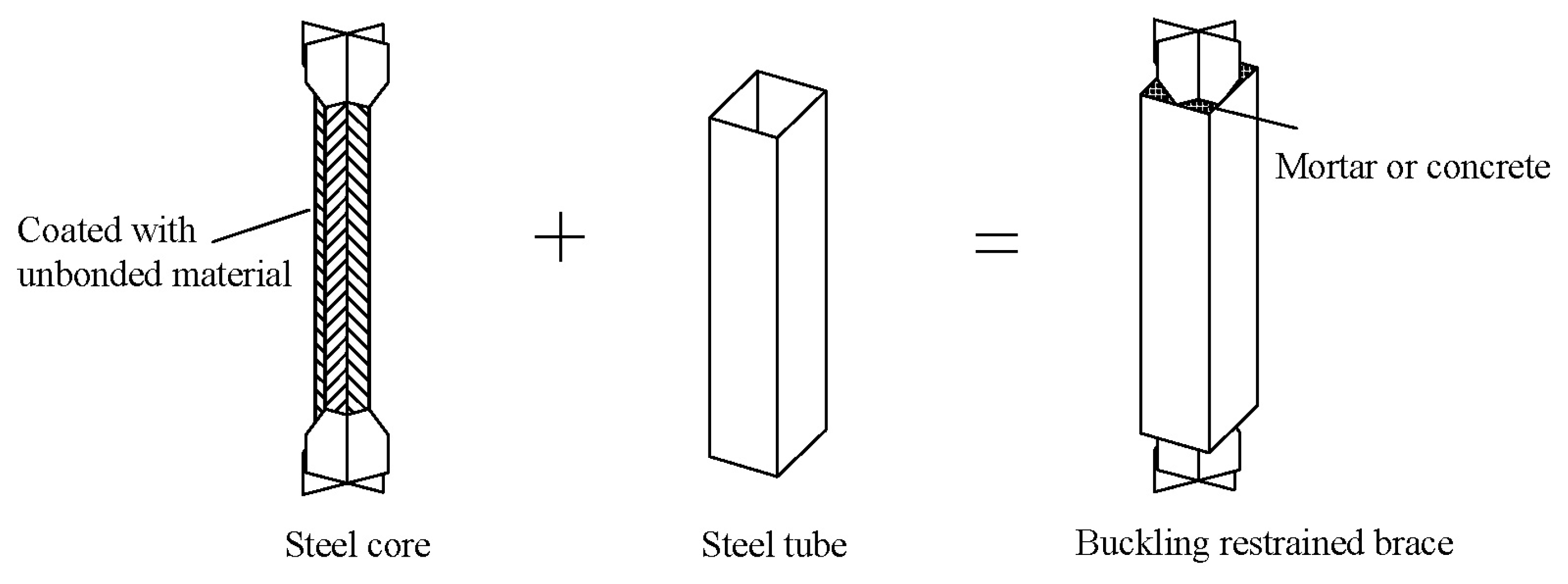


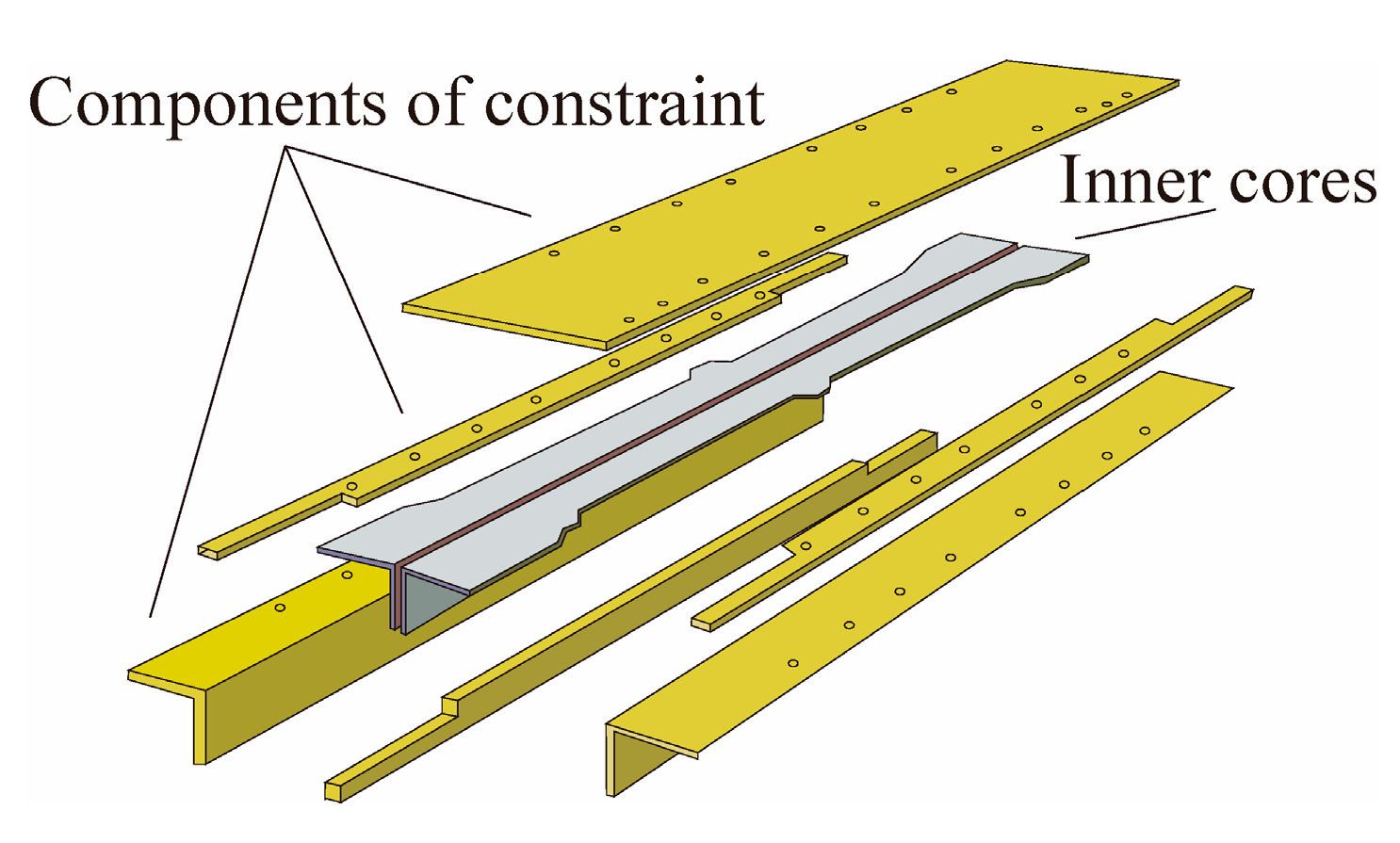

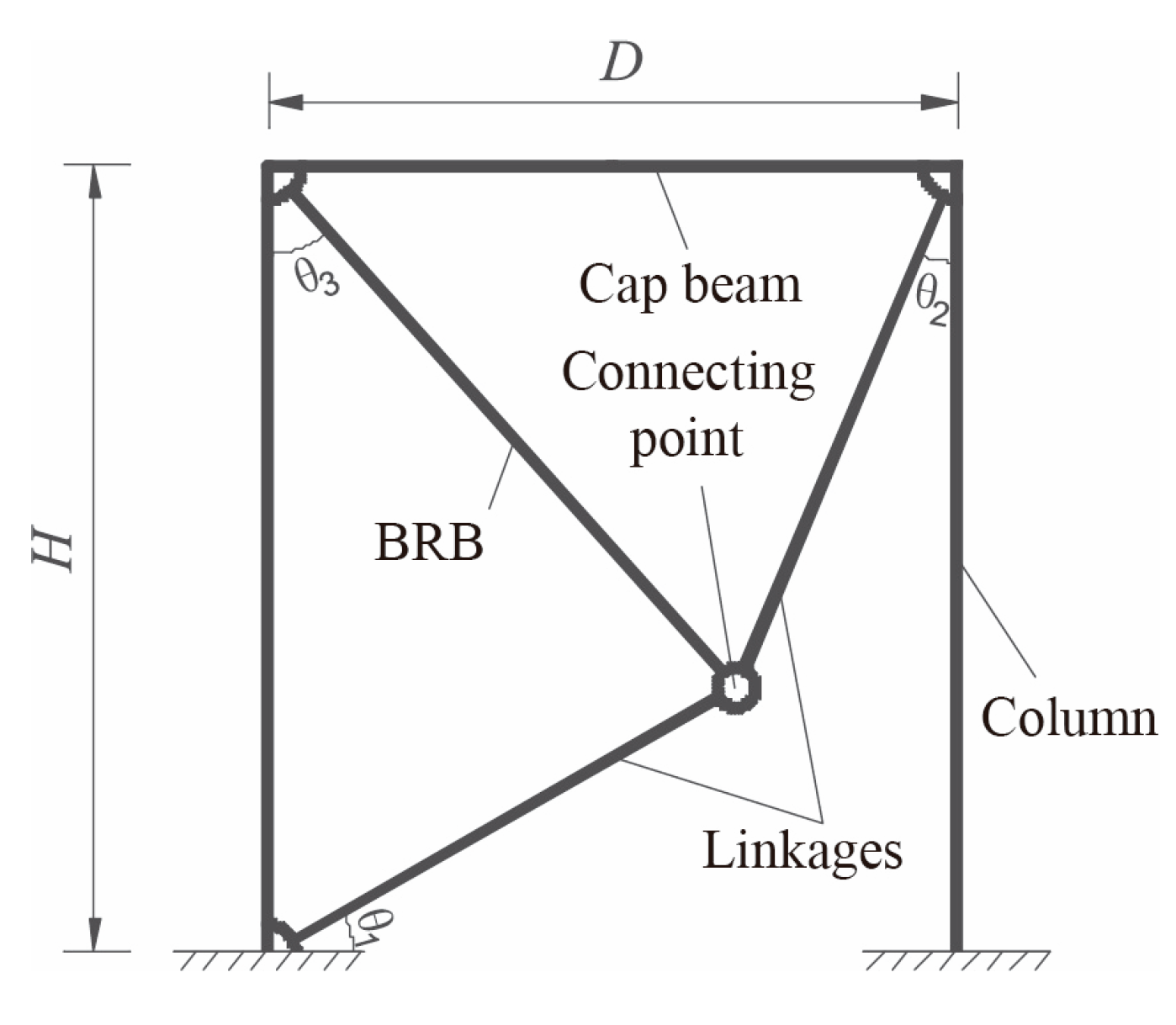
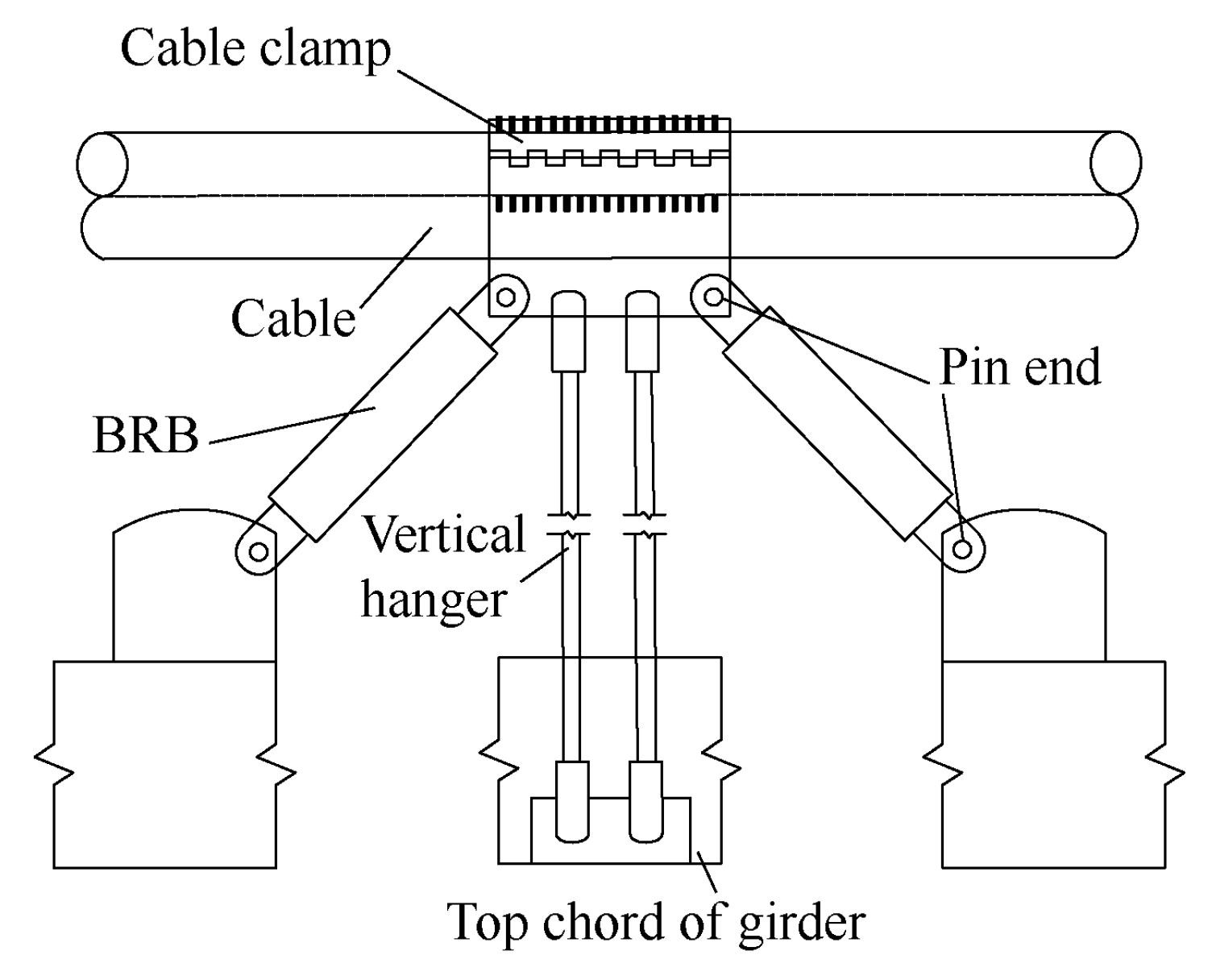

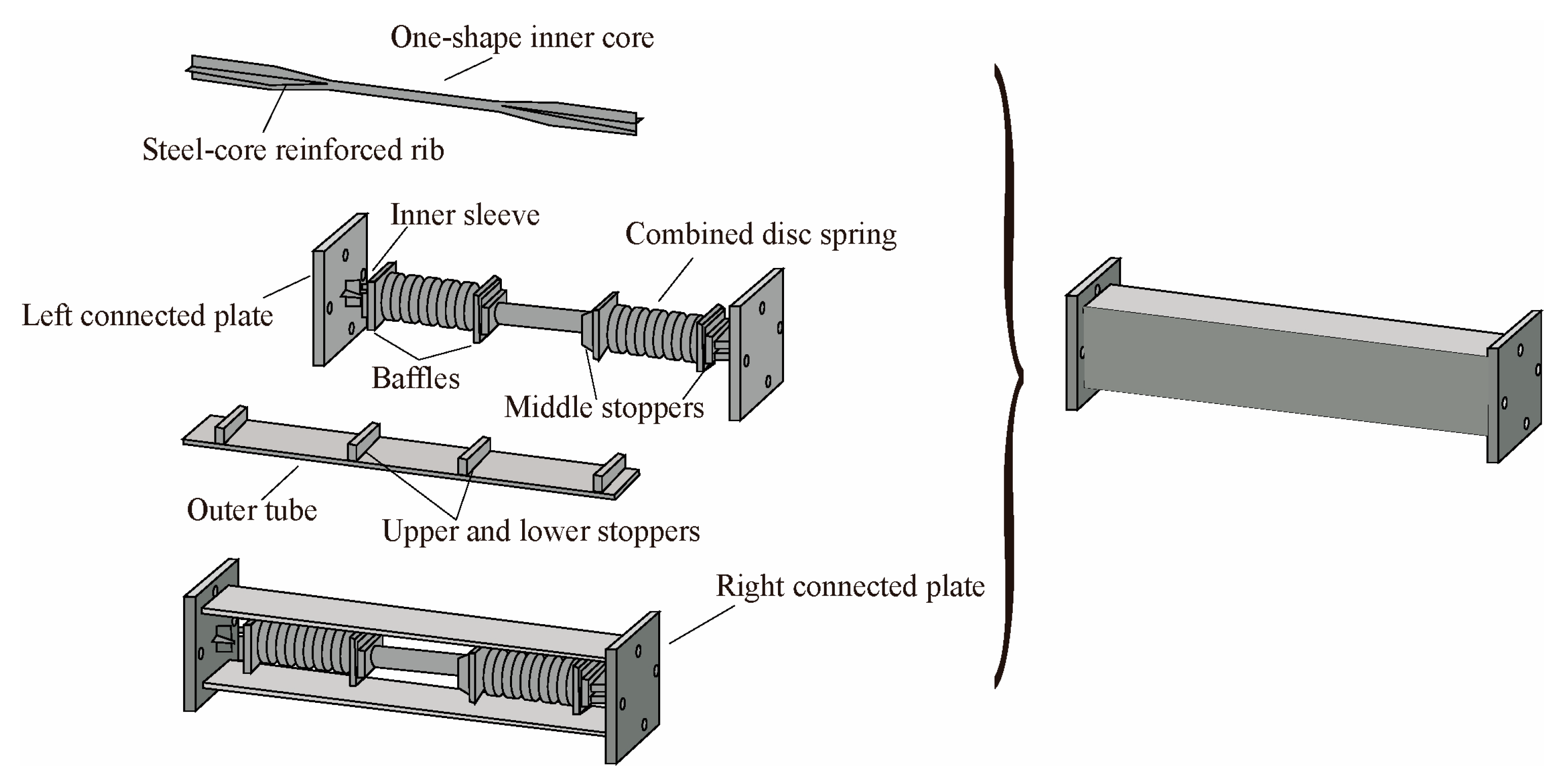

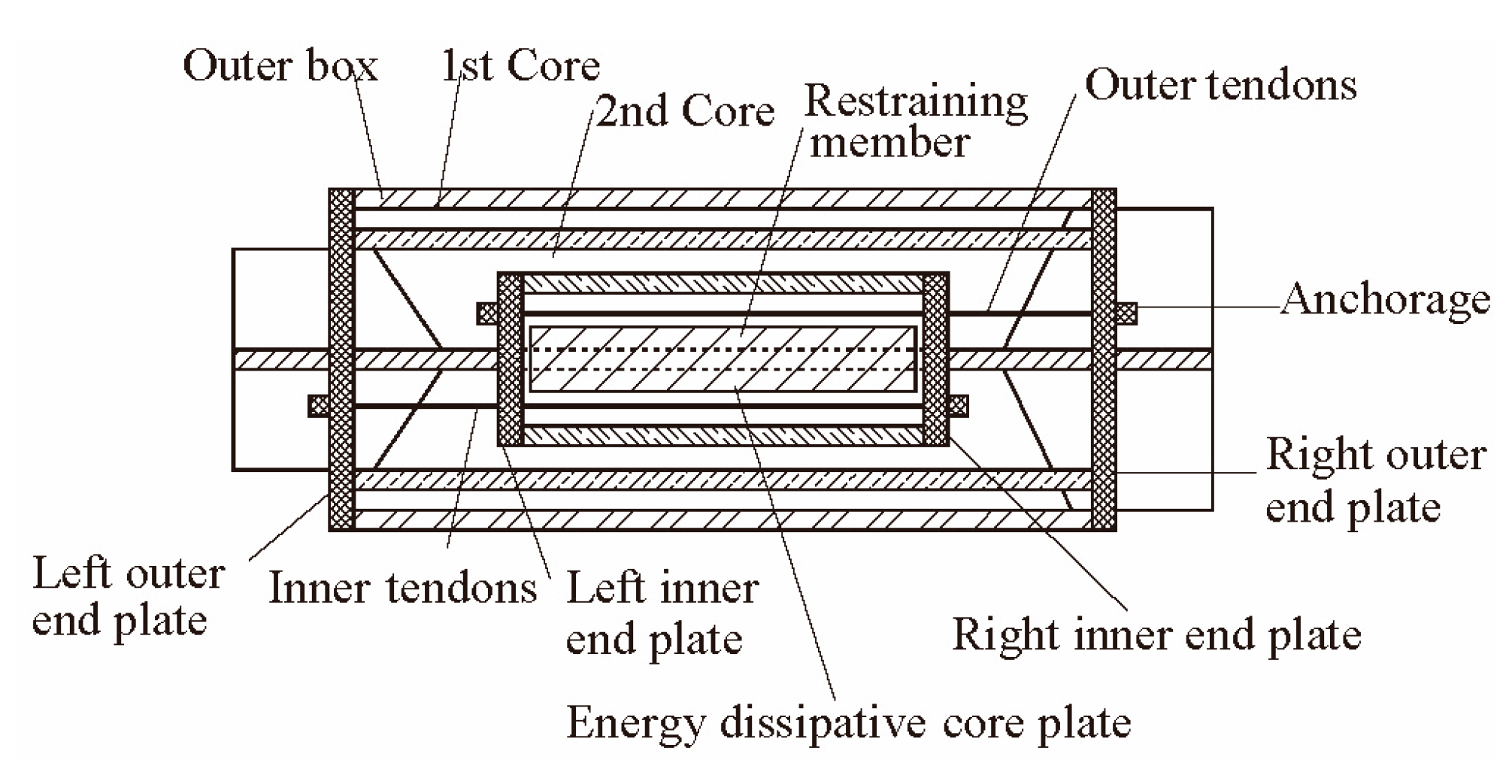
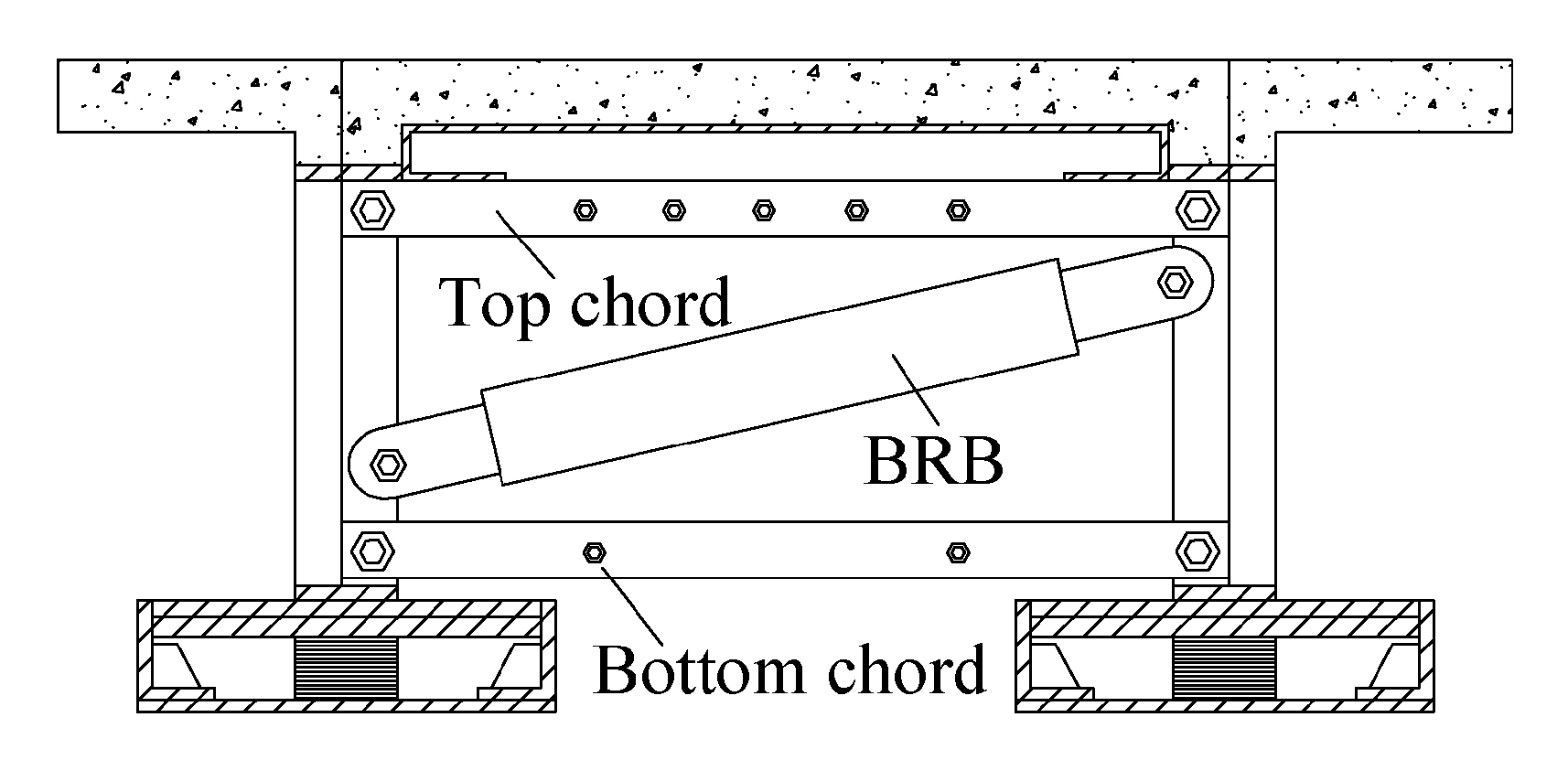
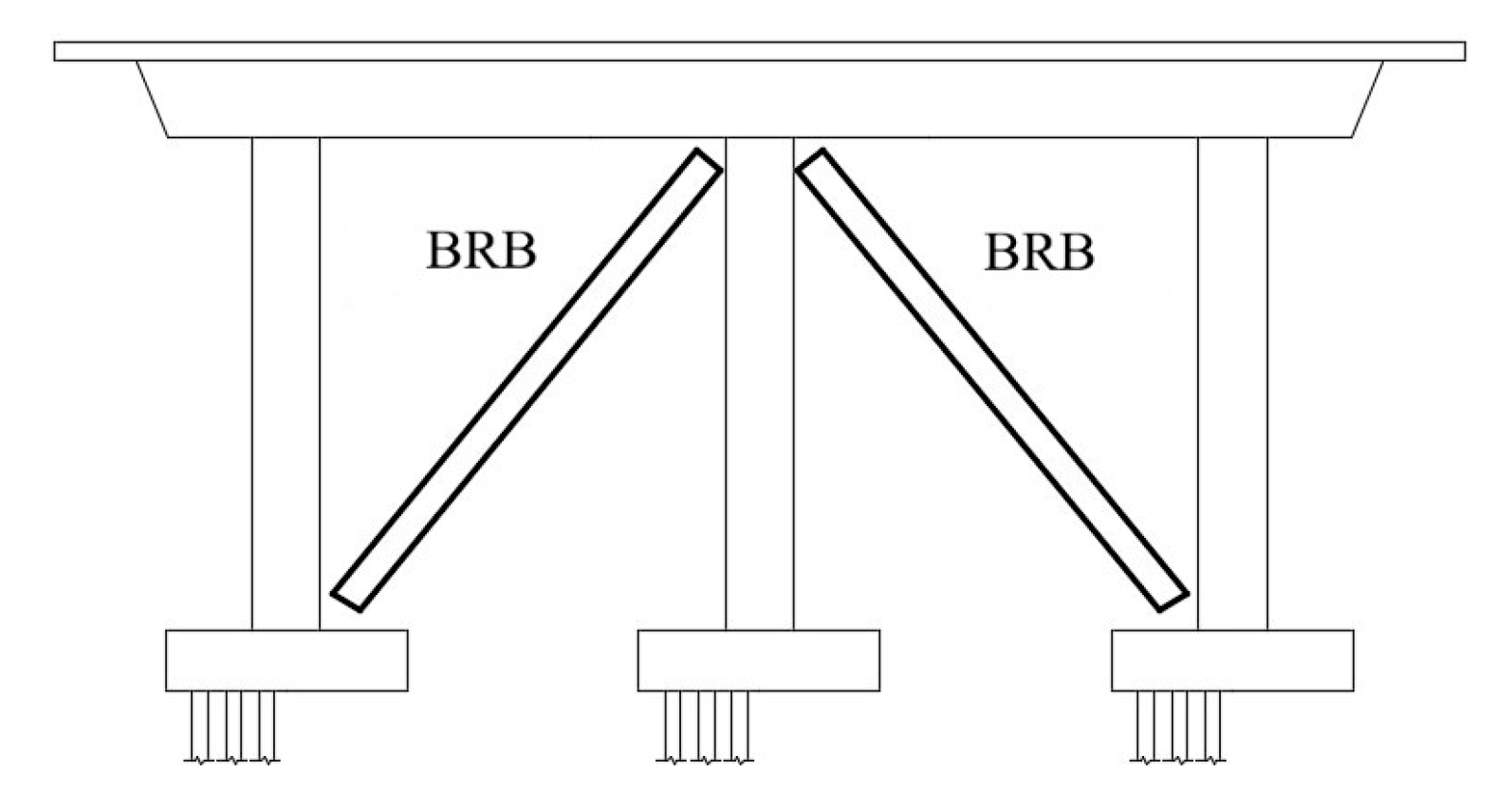

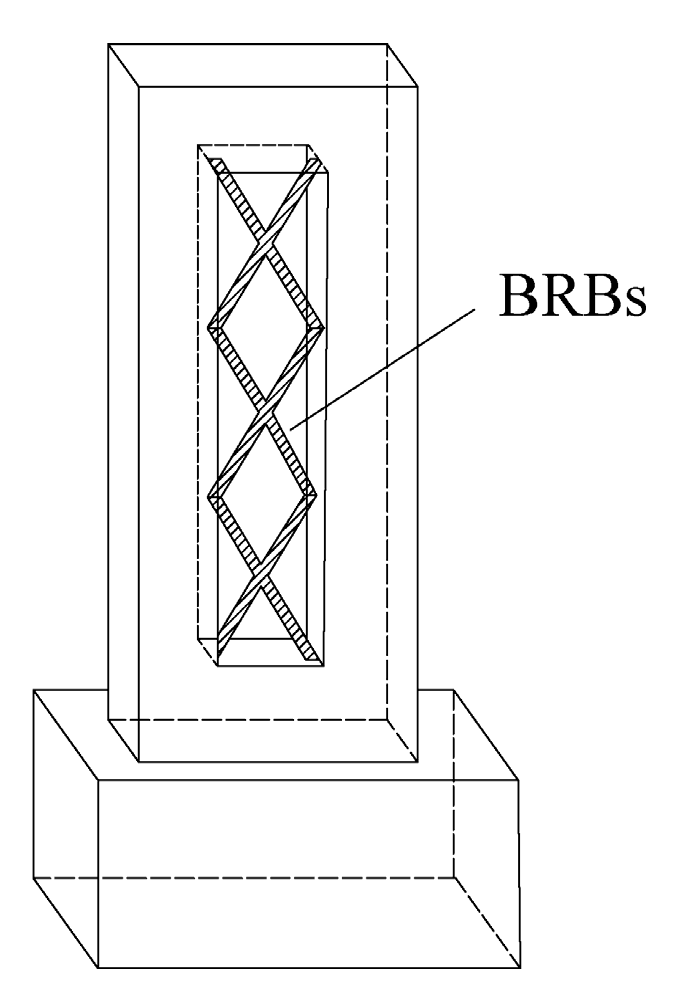
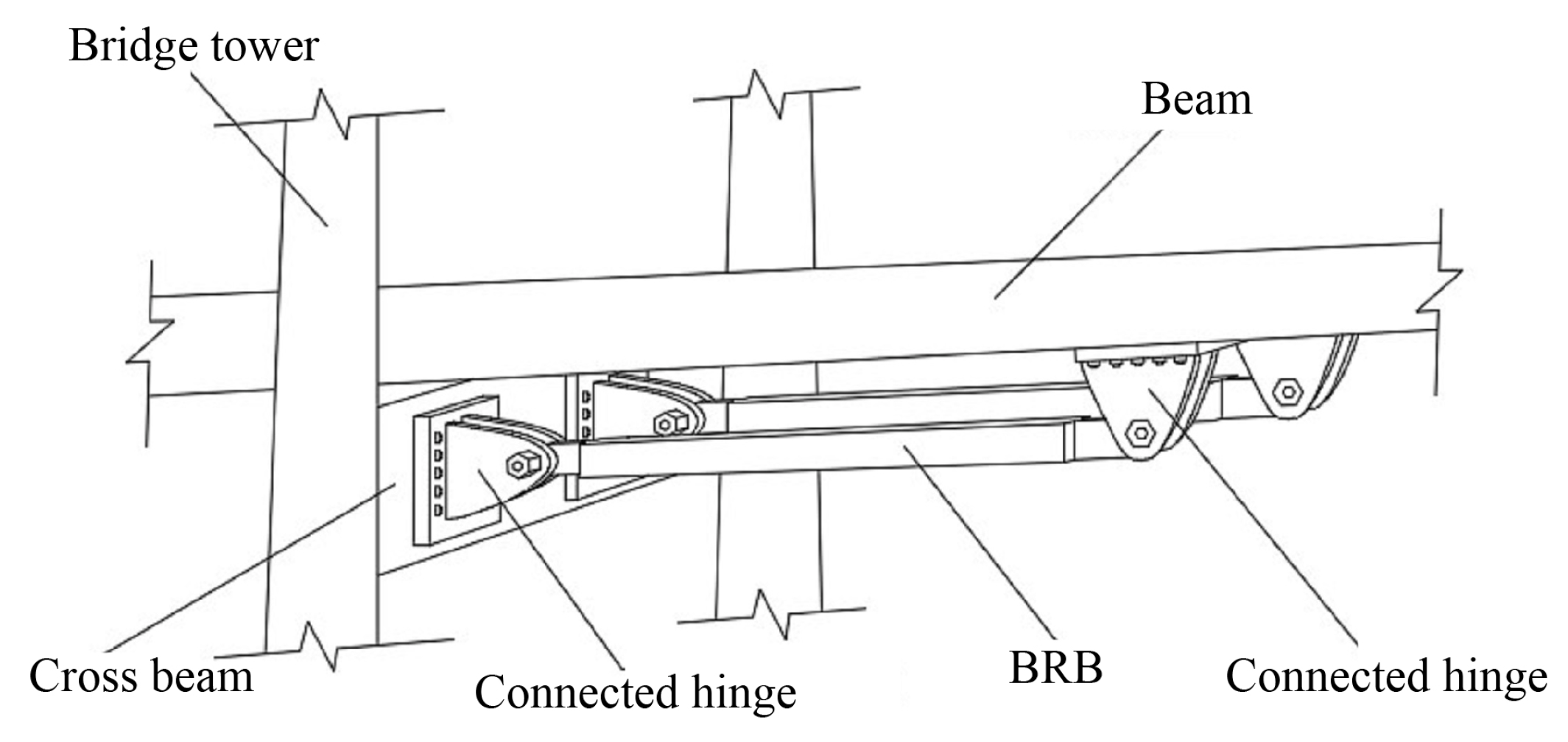
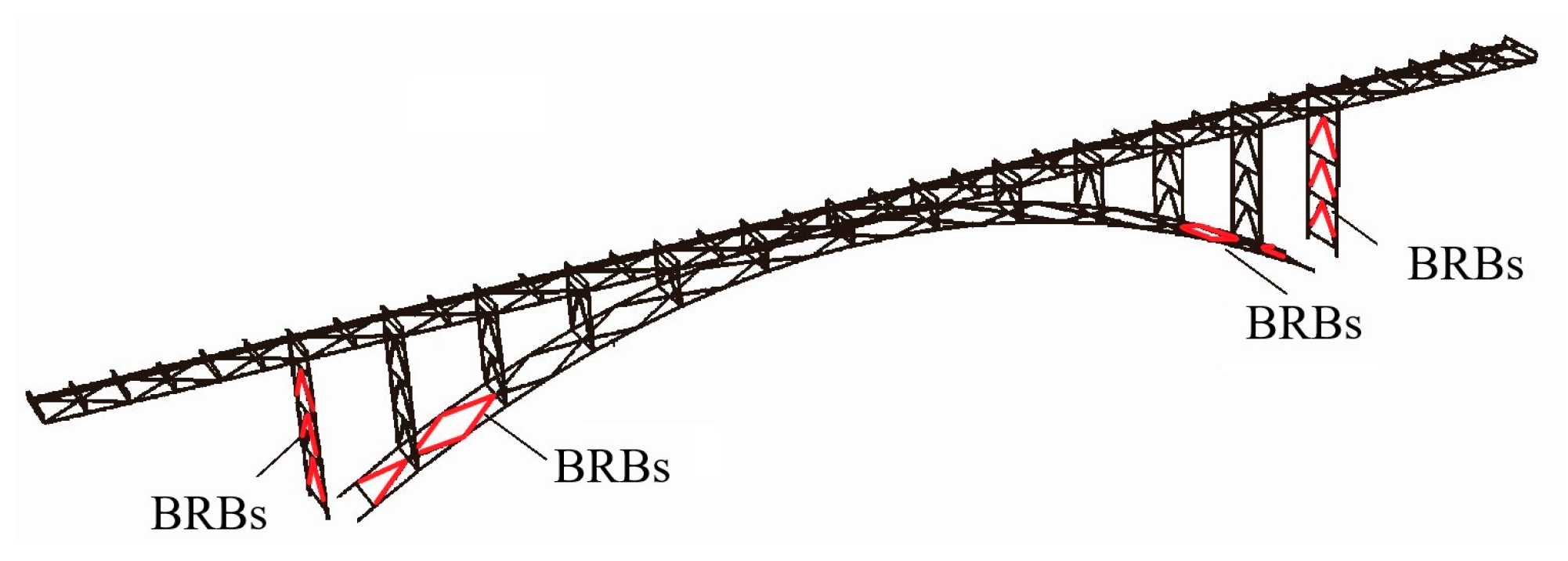

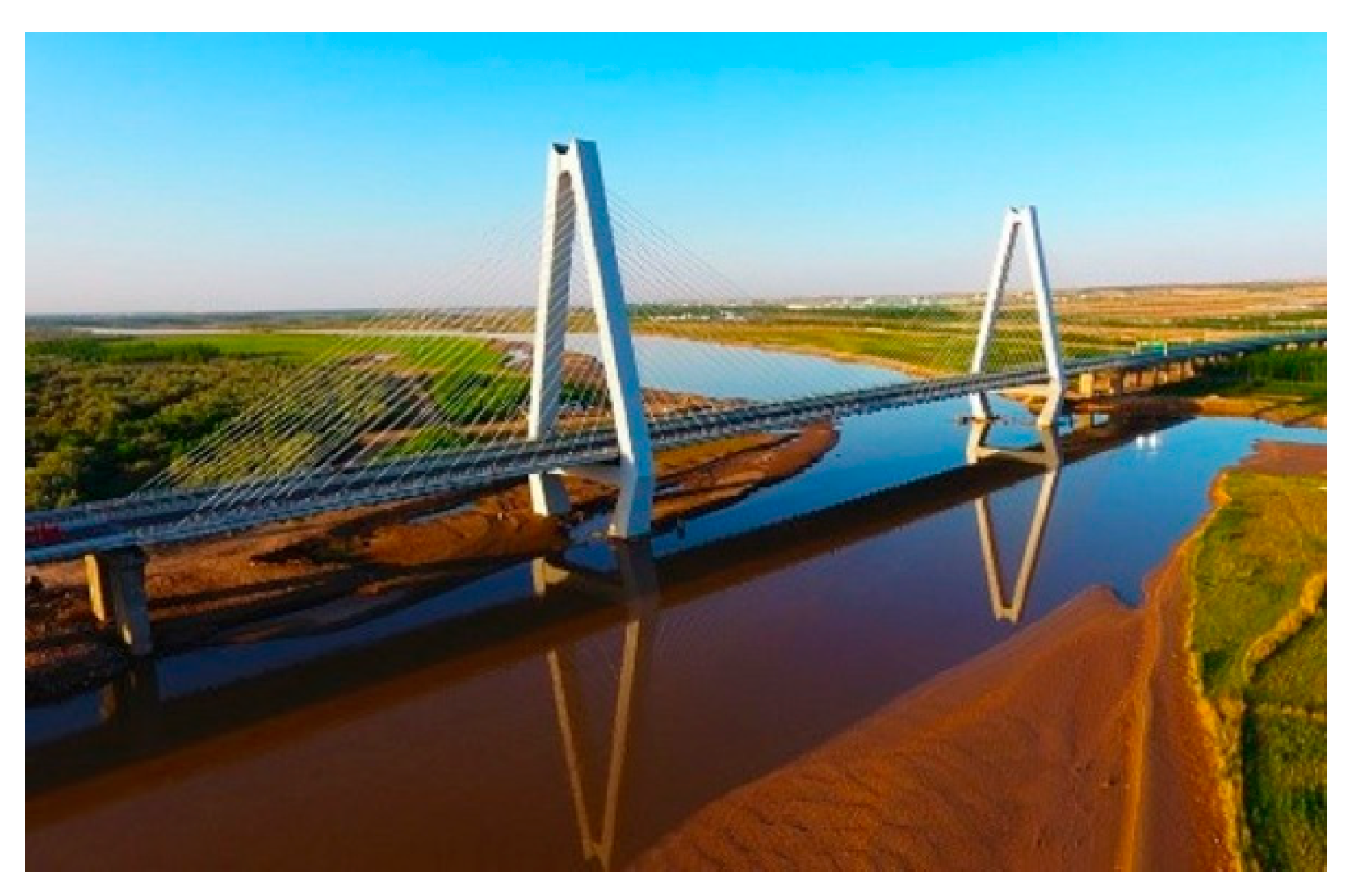

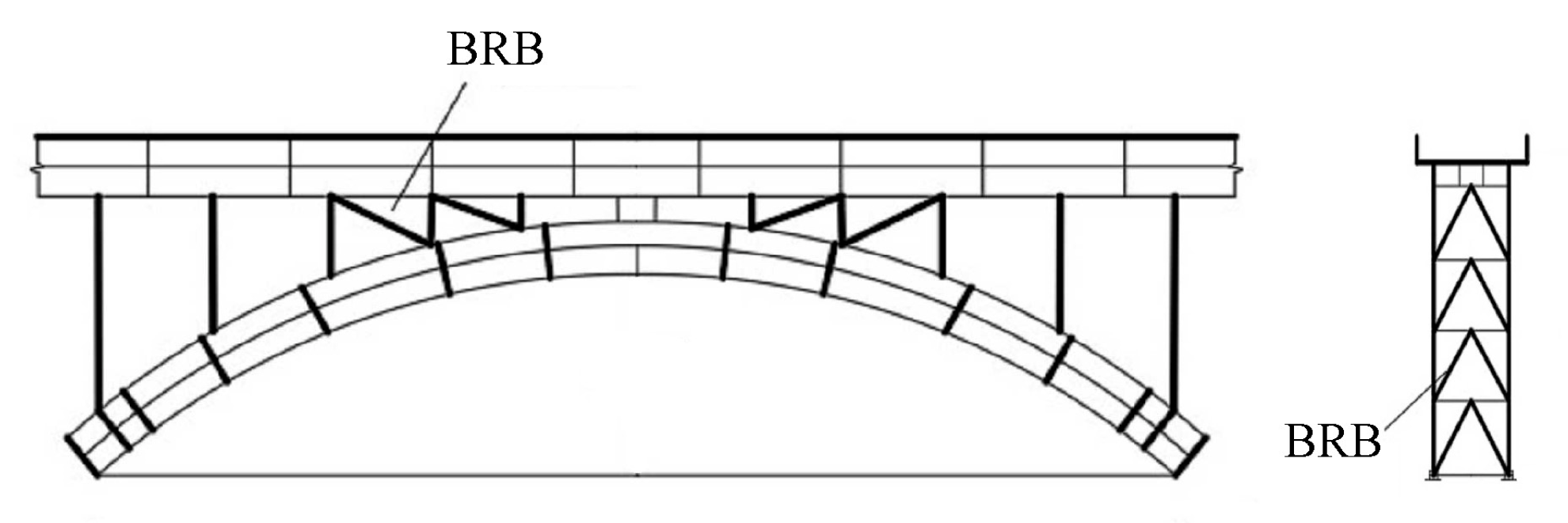


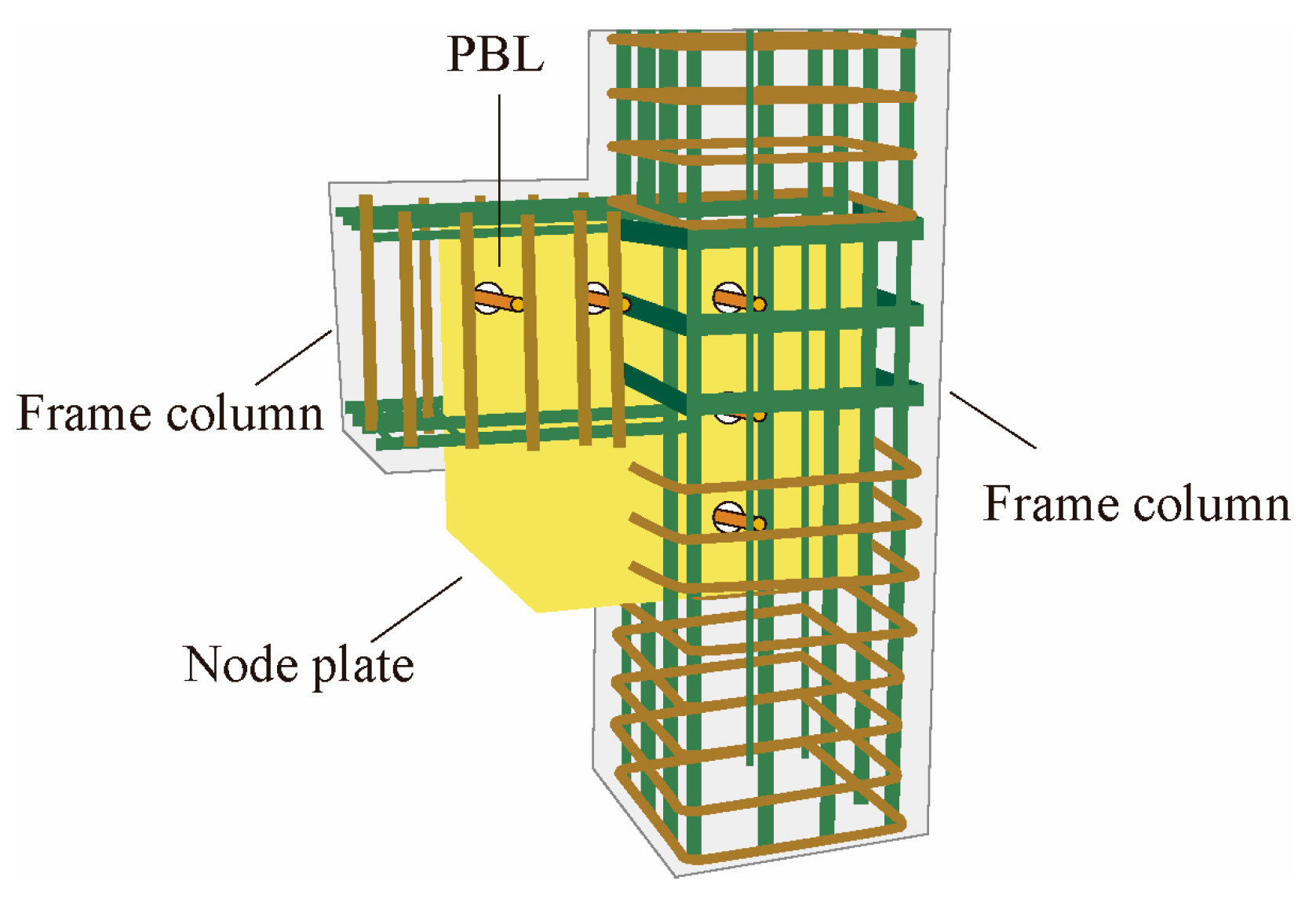
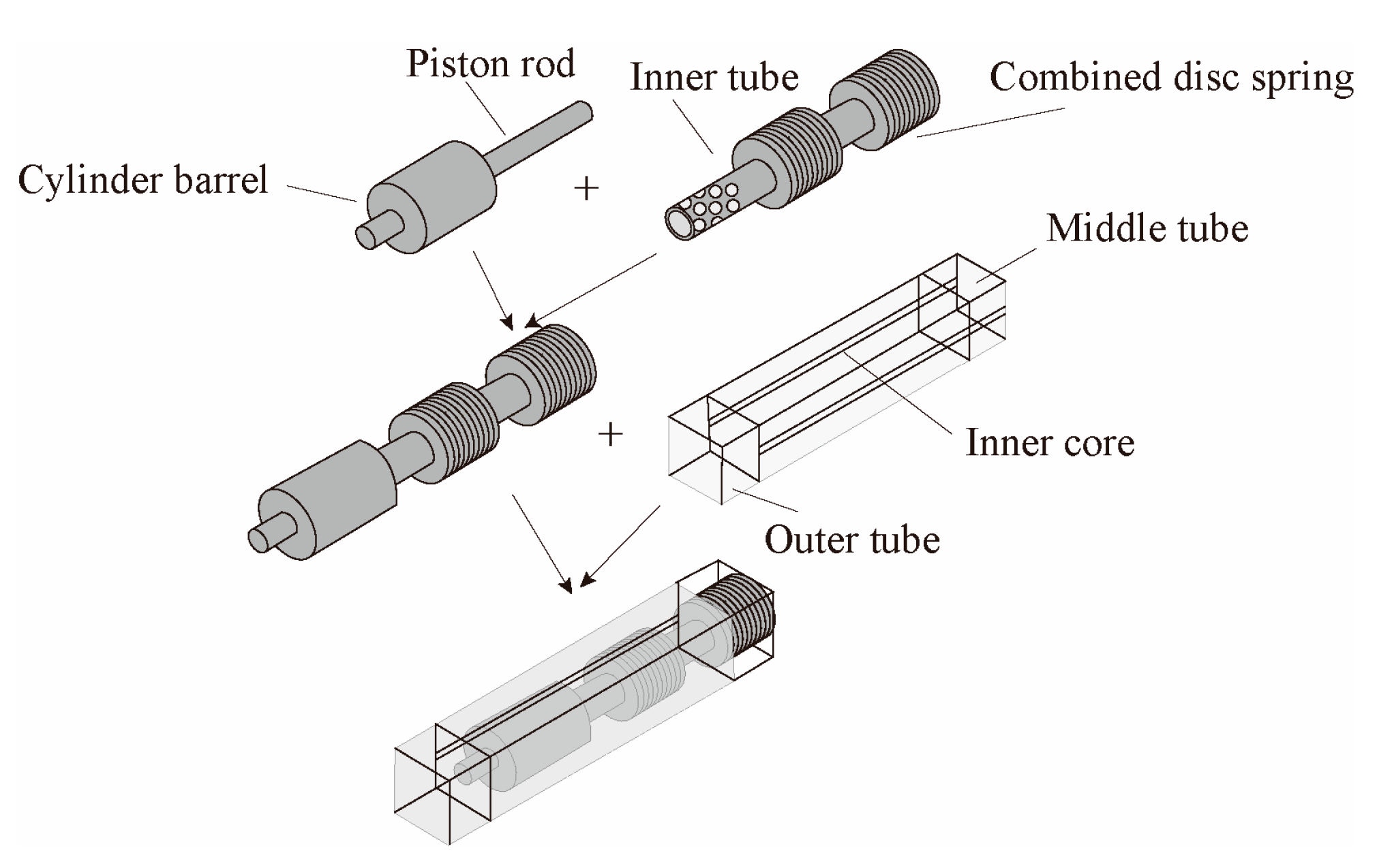
| Types | Main Advantages | Main Disadvantages | |||||
|---|---|---|---|---|---|---|---|
| High Energy Dissipating Capacity | Light Weight | Simple Construction | High Load-Carrying Capacity and Stiffness | Little Residual Displacement | Friction | ||
| Materials | SMA inner core | ✓ | ✓ | ✓ | |||
| All-steel (TTC-BRB, SBED) | ✓ | ✓ | ✓ | ||||
| MFSC-BRB | ✓ | ✓ | |||||
| Aluminum alloy inner core | ✓ | ||||||
| Lightweight aggregate concrete filling materials | ✓ | ✓ | ✓ | ||||
| Configurations | DA-BRB | ✓ | ✓ | ||||
| DRSSP-BRB | ✓ | ✓ | |||||
| TBRB | ✓ | ✓ | |||||
| PCBRB | ✓ | ✓ | ✓ | ✓ | |||
| A toggle BRB system | ✓ | ||||||
| DY-BRB | ✓ | ✓ | |||||
| BRB central buckle | ✓ | ✓ | |||||
| SC-steel-BRB | ✓ | ||||||
| DS-SCB | ✓ | ✓ | ✓ | ||||
| SC-BRB | ✓ | ||||||
| SC-sandwiched-BRB | ✓ | ✓ | |||||
| Bridges | Location (BRB) | Advantages | Disadvantages |
|---|---|---|---|
| Curved Beam Bridge (girder bridge) | Between the cover beam and pier | BRB improved the seismic performance of bridges [53,54]. | Residual deformation |
| A reinforced-concrete anti-bending bridge (girder bridge) | Between the piers | BRB improved the displacement ductility of the structure and controlled the damage of the existing vulnerable reinforced concrete bent. [55,56] | - |
| A curved high-pier bridge (girder bridge) | Between tie beams | BRB could effectively reduce the seismic vulnerability and improve the performance of the bridge [57]. | BRBs only mitigated the local seismic demands. |
| A box-girder bridge (girder bridge) | Between the cover beam and the pier | BRB could reduce the bending moments, displacements, and the potential damage [58]. | - |
| A post-tensioned bridge (girder bridge) | Between the cap beam and the footings | BRB could make bridge restore quickly [59,60]. | - |
| A double-column girder bridge (girder bridge) | Between the piers | BRB could improve the transverse stiffness of the bridge and energy dissipation capacity [61]. | Residual deformation |
| A straight steel bridge (girder bridge) | On the end diaphragm | BRB could effectively resist the longitudinal and transverse seismic forces [62]. | - |
| A single-span steel slab-on-girder bridge (girder bridge) | On the end diaphragm | BRB had the ability to withstand bidirectional displacement demands [63,64]. | Temperature changes had an effect on BRBs. |
| Long-span cable-stayed bridges | Between the piers | BRB improved the energy dissipation capacity of the auxiliary pier [66]. | The higher the yield strength of BRB, the less early energy consumption. |
| A concrete cable-stayed bridge | Across the section of pier | BRB improved the transverse seismic performance of the side span pier column [67]. | BRB form of section would affect. |
| A cable-stayed bridge | Between the cross beam and the beam | BRB greatly reduced the bending moment of the tower (pier) [68,69]. | The relative displacement control of the support and the top of the tower by BRB is limited. |
| A steel arch bridge | On the columns and main arch | BRBs improved the seismic performance of the bridge [70,71]. | Residual deformation |
| A long-span steel truss railway arch bridge | At the bottom and top of the chord planes | BRB reduced the internal forces at the bottom section of the columns on each arch [72]. | The seismic response of some bars in the arch would be increased. |
| Arch bridges | Replace beams or transverse braces | BRB improved the energy dissipation capacity and damping effect [73,74]. | - |
| A steel truss arch bridge | Replace a portion of the normal bars | BRB could reduce the internal forces and displacements of the arch ribs [75]. | - |
| Light flexible arch bridges | Between bent piers | BRB could improve the lateral seismic performance of bridges [76]. | The damage of high piers might increase. |
Disclaimer/Publisher’s Note: The statements, opinions and data contained in all publications are solely those of the individual author(s) and contributor(s) and not of MDPI and/or the editor(s). MDPI and/or the editor(s) disclaim responsibility for any injury to people or property resulting from any ideas, methods, instructions or products referred to in the content. |
© 2023 by the authors. Licensee MDPI, Basel, Switzerland. This article is an open access article distributed under the terms and conditions of the Creative Commons Attribution (CC BY) license (https://creativecommons.org/licenses/by/4.0/).
Share and Cite
Li, X.; Zou, J.; Zhao, Y.; Wang, D. Research on the Application of BRBs in Seismic Resistance of Bridge. Materials 2023, 16, 2549. https://doi.org/10.3390/ma16072549
Li X, Zou J, Zhao Y, Wang D. Research on the Application of BRBs in Seismic Resistance of Bridge. Materials. 2023; 16(7):2549. https://doi.org/10.3390/ma16072549
Chicago/Turabian StyleLi, Xiaoli, Jina Zou, Yuemin Zhao, and Dongsheng Wang. 2023. "Research on the Application of BRBs in Seismic Resistance of Bridge" Materials 16, no. 7: 2549. https://doi.org/10.3390/ma16072549
APA StyleLi, X., Zou, J., Zhao, Y., & Wang, D. (2023). Research on the Application of BRBs in Seismic Resistance of Bridge. Materials, 16(7), 2549. https://doi.org/10.3390/ma16072549






